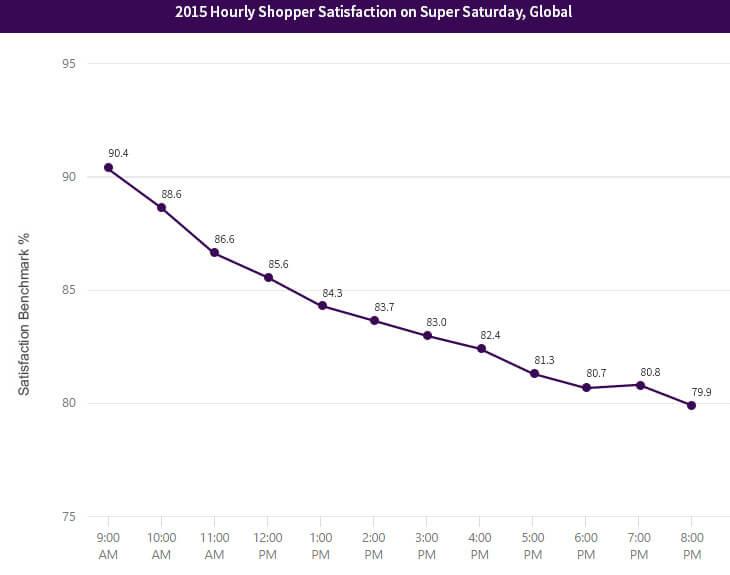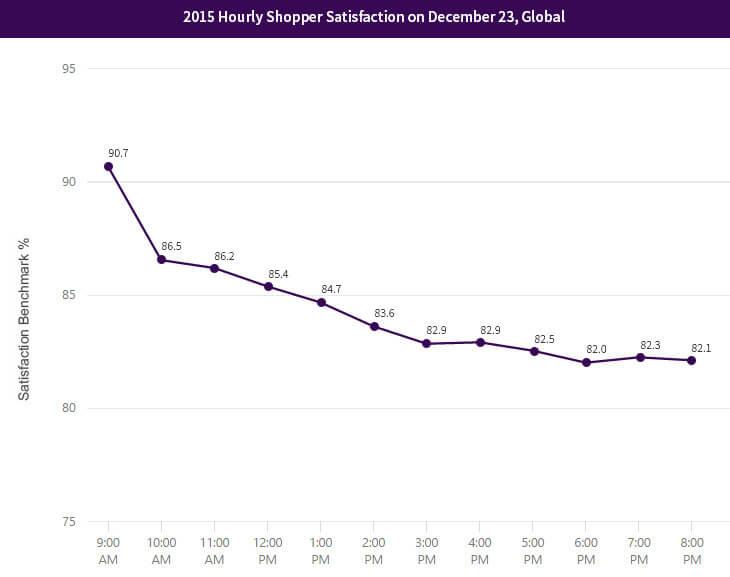HappyOrNot’s Message to Retailers: Boost Your Holiday Sales with Happier Shoppers
Retailers expect bigger crowds than ever this holiday season, especially on Super Saturday. Happy shoppers mean higher spend – but do Retailers know if their shoppers will be happy or not?
The last month before Christmas is always crunchtime for consumers and retailers. As much as 40 percent of the season’s sales occur in the 10 days leading up to Christmas, according to the National Retail Federation, and RetailNext, a firm that tracks retail shopper traffic, identifies the top two biggest shopping days this year will be Super Saturday December 17 and Friday December 23.
When it comes to retail sales, the customer is king. And it pays for retailers to know how shopper satisfaction levels develop throughout the day on these peak trading days. HappyOrNot®, the leading customer and employee satisfaction improvement service, has analyzed its data of these two busiest days in 2014 and 2015 – a total of 1.1 million retail consumer feedbacks – to identify the satisfaction trend and help retailers attain happier shoppers and higher sales.
What to watch: shopper satisfaction during peak shopping days
Super Saturday
The Saturday before Christmas, coined as “Super Saturday”, is emerging as the overall busiest shopping day of the holiday season. To ensure shoppers get the best in store experience, retailers should take notice of the following satisfaction statistics:
- Shopper satisfaction drops on average 1 percent every hour during standard open hours 9AM to 9PM
- Overall shopper satisfaction decreases nearly 11 percent over the entire day

December 23
Credited as the second most busy day, many shoppers are rushing to buy last minute gifts with little consideration of price. Like the Super Saturday trend, shopper satisfaction declines consistently throughout the day. The hourly results are only slightly better. Unlike Super Saturday, the trend plateaus after 3pm to maintain an 82.5 percent average.

According to HappyOrNot’s data, these key trading days represented the same downward trends in 2014 and are expected to also occur in 2016. Though shopper dissatisfaction is a repeated trend, there are proactive measures retailers can take to ensure they offer consumers the best shopping experience, which will contribute to a boost in year-end sales.
Tips to having happier shoppers (and more sales)
SMG report states that a happy shopper will spend up to 40 percent more during each visit, and, TNS indicates that up to 30 percent of shoppers will walk away from a purchase if they have a bad experience. To combat the unhappy shopper trend, HappyOrNot recommends that retailers prepare in the following ways:
- Plan adequate work-shifts, especially during the peak traffic hours of 2 – 5pm
- Ensure sufficient product stock is available and easily accessible for shoppers
- Place added focus on staff motivation and support, as positive staff attitudes reflect positively on consumers
An example of an international retailer which recognizes the importance of measuring shopper satisfaction is Dixons Carphone. Paul Justice, Central Operations Director of Dixons Carphone, describes initiatives taken:
“Having visibility of how our customers feel about shopping in our stores on an hourly basis allows us to optimise our colleague deployment, particularly around the planning of break times and working patterns. HappyOrNot is a key tool in understanding how the customer experience can change on key trading days, such as Black Friday and Boxing day where we see the largest volume of footfall and this is enhances our ability to identify where we have further opportunities to improve customer satisfaction and business performance.” Read the original article here.
About HappyOrNot
HappyOrNot® is the global leader in instant customer and employee satisfaction reporting. Our innovative feedback collecting smileys and intelligent data analytics reporting service help our clients to improve their customer experience, relationships, and employee engagement. We serve over 2,500 companies across 98 countries and have collected and reported on over a quarter billion feedbacks.